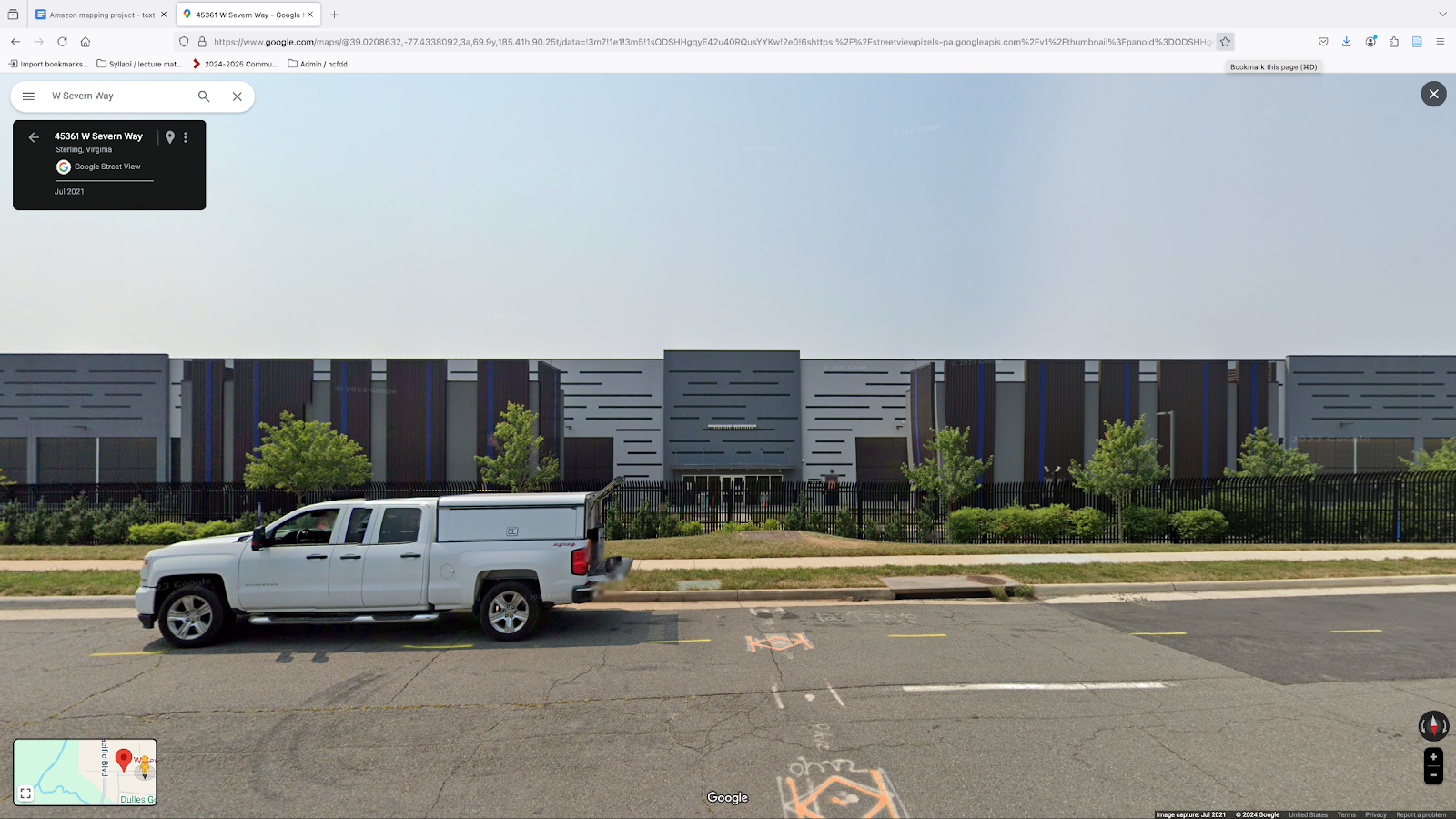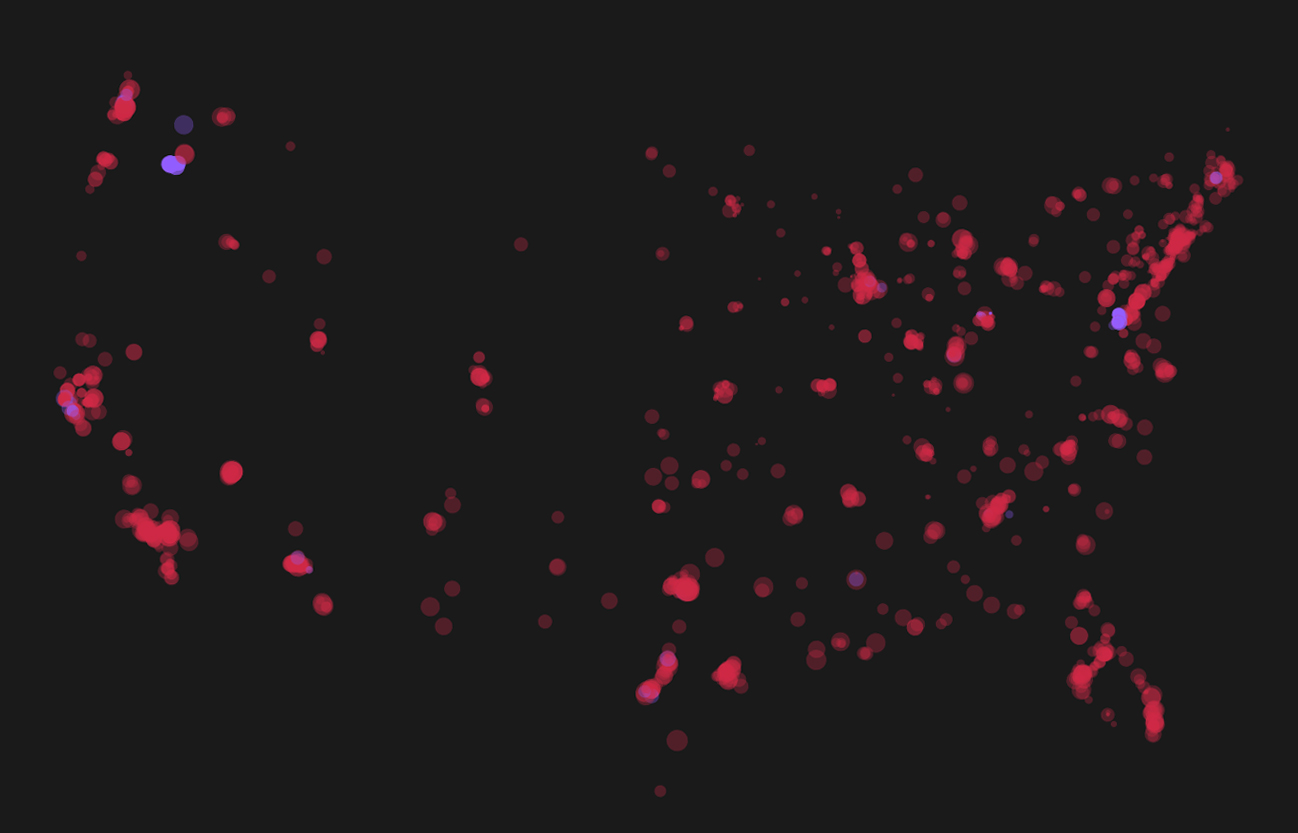Data Story
A Research Paper Exploring How Amazon is Transforming Landscapes and Communities
By Lauren Bridges1 and Ethan McFarlin2 (2024)
[I] Clouds and Concrete
This section serves as an introduction, explaining the scope of Amazon’s physical and digital infrastructure, and setting the stage for a deep dive into its socio-economic and environmental consequences.
- Highlights the rapid expansion of Amazon over the past 5 years
- Highlights the ownership vs rental numbers
- Give insight into key statistics from the data
- Foreshadows the threshold of community dissent
- Amazon’s pre-emptive strategy to control dissent
Driving along route 28 from Chantilly to Sterling in Northern Virginia, you may not notice the cluster of gray buildings with blue ribbons of paint set back from the road, dotted with newly planted young trees. If you did, you might assume these are the office buildings of an unnamed defense contractor – a common employer of these parts. If you looked closer you might notice the strange lines of the building which don’t follow regular ceiling heights of an office, or the few cars in the parking lot, the lack of windows, the security cameras, and the black metal fence that curves into spikes pointing outward. These unnamed buildings are Amazon’s data centers and they look eerily similar to the warehouses you might find along I-95 in New Jersey, I-15 south of Chicago, I-45 south of Dallas, or the I-10 connecting Los Angeles with the Inland Empire.

(Author screenshot: Oct 8, 2024)
Entering into the Prime Land map presents a picture of Amazon’s built structures – its data centers and warehouses – dotted across the United States in relation to the communities that surround these buildings. The workers and computers inside these buildings are the operational engine that work around the clock to ensure the constant flow of goods and data to uphold the promises of a digital society that’s always connected and awaiting your next clickable purchase.
The map opens with a measure of social vulnerability in the census tracts where an Amazon structure is located. The larger the size of the bubble, the higher the social vulnerability faced by the community living in the same census tract, as measured by the U.S. census. Some areas look like a virus spreading in urban networks and along well-traveled highways. Other dots stand out as lone locations peppered across the middle of states – Rapid City, South Dakota; Abilene, Texas; Springfield, Missouri; Jerome, Idaho.
[II] Infrastructures of Difference: How Amazon is dividing up America with its infrastructures
This section provides an overview of the different social and environmental factors related to Amazon’s different infrastructures. For example, warehouses bring diesel emissions and lower income jobs, while data centers bring power and water demand and higher paid jobs.
- Why does Amazon locate certain infrastructures in certain communities?
- What are the characteristics of those communities?
- Factors which predict Data Centers or Warehouses
- Broad trends across America and homing in on hot spots for development
- Cite Fulfillment by Alec MacGillis
-
Introduce states for a deeper dive
- California, Virginia, Washington, Texas, Ohio, Oregon, Illinois, New Jersey, Arizona, Florida, Georgia
- Industrial history, sociodemographic
[III] Logistical Landscapes: Reconfiguring Space for Profit (SVI)
A look at Amazon’s expansion, including urban and rural transformations, the displacement of communities, and the role of logistics in reshaping the landscape.
- Socioeconomic characteristics of communities from warehouses and data centers
- Related health impacts
- Demographic factors which predict where Amazon’s warehouses will be located
[IV] Environmental Trade-Offs: The Hidden Cost of Convenience (EJ)
A deep dive into the environmental consequences of Amazon’s facilities, covering resource consumption (e.g., energy and water), emissions, and how these centers contribute to climate change and local ecosystems.
- Socioeconomic characteristics of communities from warehouses and data centers
- Related health impacts
- Demographic factors which predict where Amazon’s warehouses will be located
[V] The Human Price Tag: Labor and Social Costs in Amazon's Shadow (labor)
A study of the human cost behind Amazon’s growth, from warehouse workers to delivery drivers, and the broader impacts on mental health, physical well-being, and quality of life in affected communities.
- Findings from OSHA investigation
-
Labor protests against heat-related and other work injuries
- East Point
- San Bernardino
OSHA citations
An OSHA investigation into 6 warehouse facilities in 5 states led to 14 record keeping violations including “failing to record injuries and illnesses, misclassifying injuries and illnesses, not recording injuries and illnesses within the required time, and not providing OSHA with timely injury and illness records.”
- OSHA investigation at Deltona, Florida; Waukegan, Illinois; and New Windsor, New York; Aurora, Colorado; Nampa, Idaho; and Castleton, New York.
East Point Picket
Warehouse workers in East Point (ALT6), a suburban city located southwest of Atlanta, formed a picket line protesting dangerous working conditions including high warehouse temperatures and unsafe equipment. Among their demands, workers asked for empty first aid kits to be restocked, a working emergency PA system, better air conditioning and ventilation, and cold clean water stations.
[VI] Thresholds of Dissent: Community Organizing against Amazon’s growing footprint
Case studies of community action organizing against Amazon’s encroachment in development hotspots.
[VII] Mapping the Future: Alternatives to the Amazon Expansion
A concluding section that explores possible solutions and alternatives—rethinking logistics, more sustainable models of consumption, or community-centered development strategies.



